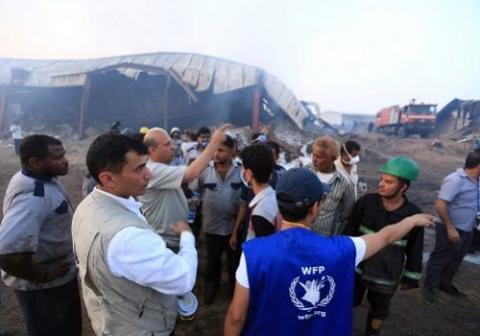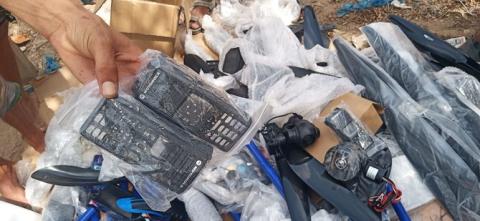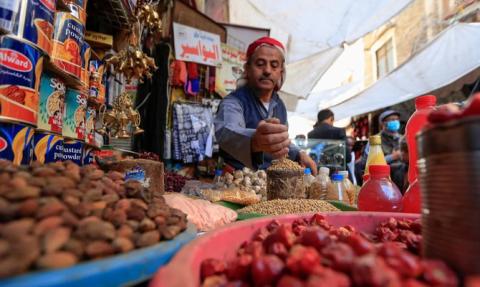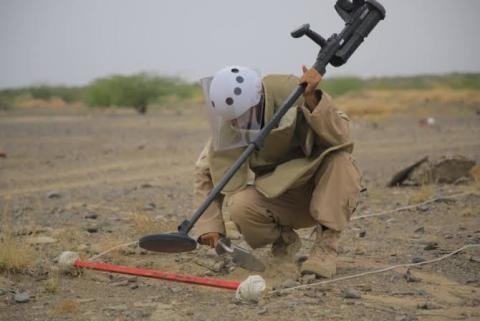The impact of explosive violence on children in Yemen


Since Houthi forces swept down from Northern Yemen into the capital Sana'a in September 2014, some 9,755 civilians have been reported injured and close to 8,736 killed by explosive violence in the ongoing conflict that has ripped the country asunder. What began as a conflict between -- on the one hand -- an alliance of Houthi rebels and those loyal to former President Ali Abdullah Saleh, and -- on the other -- the current President Abdrabbuh Mansur Hadi supported by the Saudi-led coalition, has devolved into a multifaceted and complex struggle.
The Houthi-Saleh alliance fractured in December 2017, while former coalition partners Saudi Arabia and the UAE disagree over Emirati support for the secessionist Southern Transitional Council and the Security Belt Forces. Divisions, fracturing alliances, and new axes of conflict offer little optimism that the conflict will be resolved any time soon. And in the middle lie untold thousands of civilians, young and old, facing uncertain futures.
Impact on Children
Between 2015 and 2020, at least 3,153 children have died in Yemen and 5,660 children have been injured, according to a report by UNICEF. On average, 50 children are killed and 90 are wounded or permanently disabled each month. The vast majority are harmed by explosive weapons with wide areas effects.
Saudi-led coalition airstrikes, supported by the UK and US militaries, appear to be responsible for 67% of reported civilian casualties in the war in Yemen, and are the cause of the majority of explosive violence against children. Since the conflict began, 1,372 children have been killed and 916 injured by airstrikes there.
Education
The Saudi-led coalition has carried out at least 244 airstrikes targeting schools. In 2015, 57% of UN verified attacks on schools were carried out by the Saudi-led coalition. This figure has increased to 85% in 2017 and 95% in 2019. On August 13th 2016, airstrikes in the northern Haydan District hit a school, killing 10 students and wounding 28 others. On August 9th 2018, an airstrike on the busy market of Dahyan hit a school bus, killing 26 children and wounding another 19.
Attacks on schools harm children in several ways: Yemen's 3.4 million children out of school are at increased risk of recruitment and kidnapping by armed groups, and girls are three times more likely to be the victims of forced marriage.
As the rate of Saudi-led coalition airstrikes increases, with June 2020 seeing the most airstrikes since June 2018, child victims of explosive violence are certain to increase.
Cluster Munitions
The use of cluster munitions by the Saudi-led coalition represents a long-term and pervasive threat to children in Yemen. Since 2015, the Saudi-led coalition have deployed cluster munitions at least 23 times, causing at least 16 civilian casualties from July 2015 to April 2016 and 54 in 2017.
The Saudi-led coalition have deployed 7 different types of cluster munitions: the US-made CBU-105 Sensor Fuzed Weapon, CBU-87, CBU-58, M26 rocket, the UK-manufactured BL755, and the Brazilian ASTROS-II rocket. These munitions are designed to disperse up to 650 sub-munitions across a wide area, causing indiscriminate damage.
Furthermore, whilst the direct damage from cluster munitions can be devastating, the submunitions frequently fail to explode, creating 'de facto minefields.' The size and shape of these submunitions have caused children to mistaken them for toys. According to a report by Amnesty International, a thirteen-year old boy injured by a cluster munition explosion in January 2016 described its appearance as shaped 'like a small ball you can play with.' On March 1st 2016, an eight-year old boy was killed and his brother suffered a broken jaw and the loss of three fingers, after playing with an explosive submunition. Similarly, on April 16th 2016, a 12-year old boy was killed and his brother severely injured after they played with submunitions they had found whilst herding goats.
The longevity, indiscriminate nature, and visual appeal of cluster munitions make them a severe threat to Yemen's children. Whilst cluster munition use has been curtailed since 2017, unexploded submunitions will continue to harm Yemen's children in the absence of an extensive unexploded ordinance clearance programme.
Landmines
Remote explosive devices have caused at least 5,500 casualties in Yemen since 2015. 80% of these casualties have occurred since 2017, coinciding with a drastic increase in landmine use by the Houthi rebels. According to some estimates, Houthi-aligned forces have laid one million landmines since the war started, making Yemen one of the most heavily mined countries since the Second World War, according to a 2019 report by ACLED.
This prolific use of anti-personnel and anti-vehicle landmines by the Houthis represents a strategic decision to defend and cover their withdrawals from key cities such as Aden in 2015 and Al Hudaydah in 2018. Following the Emirati-backed offensive on Al Hudaydah in June 2018, civilian deaths caused by landmines increased 279% from an average of three per month from January to June, to an average of 12 per month from June to December. Al Hudaydah has been badly affected by Houthi landmines, with the southern districts of At Tuhayta, Ad Durahyimi, Al Khawkhah, and Hays accounting for 70% of Yemen's landmine casualties.
Between 2016 and 2020, ACLED has confirmed 267 civilian casualties caused by landmines. An estimated 140 civilians have been killed by such weapons, according to Human Rights Watch. AOAV reported that the indiscriminate use of landmines by Houthi rebels has had a devastating impact on Yemen's children, with at least 27 child casualties caused by landmines since 2015.
Alongside this devastating physical toll, landmines represent a continuing threat to Yemen's children by denying access to clean water facilities and grazing lands. The deliberate effort to deny access to clean water is particularly damaging, with Houthi rebels mining wells and other water facilities in several western coast locations, including al-Zuhairi, Mokha, al-Hayma, Khawkha, as well as at the main water station in Tuhayta. Prolific landmine use has left communities in dire need of humanitarian assistance, whilst simultaneously preventing NGOs from being able to reach those in need. Three separate NGOs have stated they were unable to provide support to areas on Yemen's western coast, due to landmines on key roads making delivering essential aid impossible.
Shelling
Since the beginning of the war in Yemen, Houthi rebels have repeatedly fired rockets and mortars into populated areas indiscriminately, killing and injuring 189 children, as reported by AOAV. Residential areas of Yemen's third largest city Taizz have been consistently shelled since Houthi forces were pushed out of the city in March 2016. Houthi forces have repeatedly fired mortars and Katyusha rockets from an elevated area in the al-Hawban district into populated areas.
In August 2015, three separate incidents of Houthi shelling killed 5 children, three of whom were killed when a rocket landed near to where they were playing football. Over a ten day period in May 2017, indiscriminate shelling caused 190 civilian casualties, killing at least four children and injuring ten more. On June 8th 2016, three children were killed when a rocket hit their school. Indiscriminate shelling of residential areas has been catastrophic to the welfare of children in Yemen.
Psychological Trauma
The physical destruction caused by airstrikes, landmines, and shelling is not the only form of suffering inflicted on Yemen's children. According to Save the Children, close proximity to explosive violence over the past five years has had a 'devastating impact on the mental health of an entire generation of children.' A study of 912 children in Yemen's capital Sana'a by CARPO
found that 79% were found to be suffering from Post-Traumatic Stress Disorder. In a similar survey of 1,250 children, 20% said they were always afraid, 52% reported never feeling safe when they were apart from their parents and 16% claimed they were rarely or never able to relax. Children in Yemen display similar indicators of trauma as children in other conflict zones, such as bedwetting, nightmares, hyper-vigilance, grief, depression, anxiety, aggression, and feeling withdrawn.
These issues can have a serious impact on a child's development, impairing their ability to engage in daily life and preventing them from performing well in school, forming relationships and attachments, or finding a sense of safety. In Yemen, each mental health nurse serves 300,000 people, and only two child psychiatrists serve Yemen's entire population. As a result, Yemen's children are unlikely to get the help they desperately need.
Conclusion
Yemen's children have endured immense suffering due to explosive violence over the past five years of conflict. Unfortunately, this suffering is unlikely to abate in the near future. Deliberate and systematic destruction of Yemen's infrastructure has precipitated a humanitarian catastrophe. 93% of children need humanitarian assistance, two million children are out of school and one in five have lost their homes.
Severe acute malnutrition currently threatens the lives of 400,000 children under the age of five and by the end of 2020 half of all under-fives could be at risk. Malnutrition has already stunted the growth of 45% of children under five, inflicting permanent damage to their physical and cognitive development. 10.2 million children do not have access to healthcare, relying on UNICEF and other NGOs for essential vaccinations, and water, sanitation and hygiene. In April 2017, Yemen suffered the world's worst cholera outbreak, and of the 2.3 million cases, 25% of those were children under five.
The devastation of Yemen through the use of airstrikes, cluster munitions, landmines and shelling has caused the death and injury of thousands of children, and the near-complete destruction of Yemen's critical infrastructure has caused a humanitarian disaster that will likely cause the deaths of thousands more before the conflict's end.

Yemeni officials on Monday condemned arrests and prosecutions by the Iran-backed Houthi militia directed against media, journalists and celebrities…

Yemen's warring parties are gearing up for new waves of conflict in 2023 amid a lack of decisive steps towards sustainable peace, adding to the suf…

The UAE will help to recruit doctors and deliver crucial supplies for hospitals in Yemen under a major healthcare drive. The Khalifa bin…